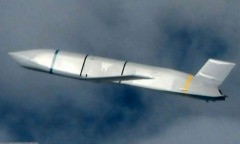By Arthur Dominic J. Villasanta , | April 06, 2017

MALDs.
The latest version of the ADM-160 Miniature Air-Launched Decoy (MALD), a decoy missile that deceives enemy air defense systems into tagging it as a larger U.S. military aircraft, has an upgraded navigation system that can jam radar systems.
The U.S. Air Force and Raytheon validated the performance of the new for the DM-160C Miniature Air Launched Decoy-Jammer, or MALD-J, in six test flights from Boeing B-52 Stratofortress strategic bombers and General Dynamics F-16 Fighting Falcon jet fighters at White Sands Missile Range, New Mexico.
Like Us on Facebook
The system upgrade is designated as the GPS Aided Inertial Navigation System or GAINS II. It improves MALD-J navigation performance in a GPS jamming environment.
MALD is a modular, air-launched and programmable decoy missile. It weighs less than 300 pounds; is 2.4 meters long and has a range of some 500 nautical miles.
MALD-J adds radar-jamming capability to the basic MALD platform. The MALD platform confuses enemy air defenses by duplicating friendly aircraft flight profiles and radar signatures. MALD-J maintains that capability and adds jamming capabilities.
It will be able to operate in both decoy and jammer modes. The decoy and jammer configurations are key enablers supporting the Air Force Global Strike, Global Response, Space and C4ISR, and the Air and Space Expeditionary Force Concepts of Operations. MALD-J will also provide jamming capability for the Airborne Electronic Attack Systems of Systems.
It will be launched against a specific target and jam specific radars to degrade or deny the detection of friendly aircraft or missiles by integrated air defense systems.
Deliveries of MALD to the US armed forces began in 2012.
In mid-2016, Raytheon secured a USAF contract to modify MALD for carriage on the U.S. Navy Boeing F/A-18E/F strike fighters.
Raytheon Space and Airborne Systems in El Segundo, California supported design work for GAINS II, while Raytheon Missile Systems in Tucson, Arizona supplied systems engineering, integration and testing.
-
Use of Coronavirus Pandemic Drones Raises Privacy Concerns: Drones Spread Fear, Local Officials Say

-
Coronavirus Hampers The Delivery Of Lockheed Martin F-35 Stealth Fighters For 2020

-
Instagram Speeds Up Plans to Add Account Memorialization Feature Due to COVID-19 Deaths

-
NASA: Perseverance Plans to Bring 'Mars Rock' to Earth in 2031

-
600 Dead And 3,000 In The Hospital as Iranians Believed Drinking High-Concentrations of Alcohol Can Cure The Coronavirus

-
600 Dead And 3,000 In The Hospital as Iranians Believed Drinking High-Concentrations of Alcohol Can Cure The Coronavirus

-
COVID-19: Doctors, Nurses Use Virtual Reality to Learn New Skills in Treating Coronavirus Patients










